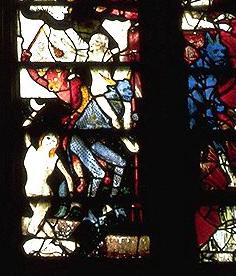 The
Windows of Fairford Parish Church, Gloucestershire, UK
(detail, right)
- pretty magnificent stuff attributed to the King's Master Glazier, Barnard Flower, working on Flemish designs. To view the whole church click on "walk through". Click on "windows in detail" to see Eve at the Fall, and note the traditional use of silverstain to produce a local yellow on clear glass, and again on blue glass to produce a local green.
- here you can see the Last Judgement Window - a magnificent thing (slow loading but well worth it), where you can also see a blue devil with green horns (bottom right), and a red devil with orange highlights.
- and here you can see more details.
The
Windows of Fairford Parish Church, Gloucestershire, UK
(detail, right)
- pretty magnificent stuff attributed to the King's Master Glazier, Barnard Flower, working on Flemish designs. To view the whole church click on "walk through". Click on "windows in detail" to see Eve at the Fall, and note the traditional use of silverstain to produce a local yellow on clear glass, and again on blue glass to produce a local green.
- here you can see the Last Judgement Window - a magnificent thing (slow loading but well worth it), where you can also see a blue devil with green horns (bottom right), and a red devil with orange highlights.
- and here you can see more details.
|


![]()

![]()